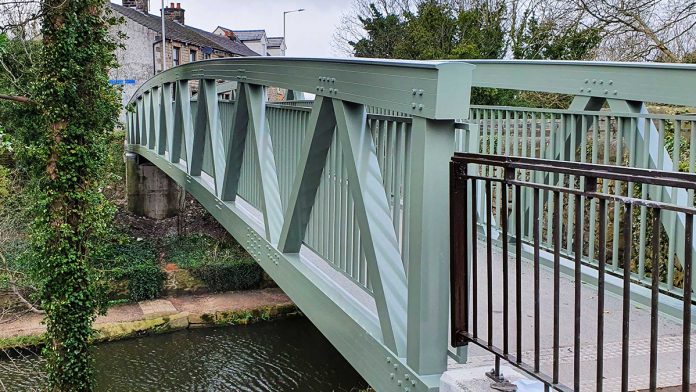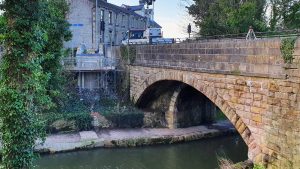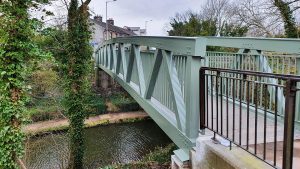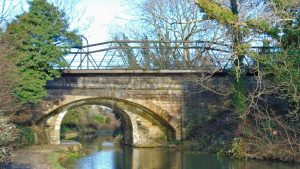APB Group, a leading UK lightweight bridge installer, has recently completed the installation of a sustainable aluminium footbridge for Lancashire County Council spanning the Lancaster Canal in Carnforth
The installation of this brand new footbridge, known locally as “the green bridge” (although originally painted brown), was completed in February 2020. The works have been carried out in line with a specific requirement from the council for a more maintenance-friendly and sustainable alternative to the traditional steel tube footbridges present at the time across the county and spanning a number of its canals and railways.
Identifying the county’s dilapidated steel tube bridges
Following a routine inspection of the dilapidated Tubewright footbridge at Carnforth, originally constructed around 1955, it was discovered that several of the hollow steel tubes from which the bridge was constructed were beginning to show signs of internal deterioration.
Over time, this deterioration would have reduced the load-bearing capacity of the bridge, which could have led to eventual catastrophic structural failure. The decision was taken by Lancashire County Council to replace the steel footbridge with a sustainable lightweight alternative as part of a series of essential maintenance works to help safeguard the public and maintain the bridges integrity for years to come.
Aluminium as a suitable lightweight bridge solution
APB Group was contracted under NEC 3rd Edition to design, build, deliver and install a suitable replacement bridge structure that was both sustainable and cost-effective.
The original feasibility report called for an FRP Bow String Truss Bridge as the preferred solution. However, it was decided by APB Group that a better solution would come from approaching one of its European suppliers, Glück GmbH , who would be able to help deliver a new footbridge with a specific focus on the use of sustainable materials to minimise any future maintenance requirements for the asset owner.
Patented solutions for the design of lightweight modern bridges
The new canal footbridge at Carnforth is the third of four bridge replacement schemes completed by APB Group for Lancashire County Council using modern construction materials, with two other similar rail footbridges having already been replaced in Ormskirk in August 2019.
Earlier bridge replacement schemes carried out by APB Group in Ormskirk saw the use of fibre reinforced polymer (FRP) structures, the fourth scheme will also qualify as the longest single span aluminium structure in the UK once installed in summer 2020.
APB’s chosen bridge manufacturer, Glück GmbH, was given the task of fabricating the bridge for Carnforth at its premises in Engen near Stuttgart in Germany.
Glück GmbH was specifically chosen for its patented method which uses hollow aluminium profiles to manufacture structures that have the capability to span greater distances with dramatically reduced overall weight than traditional steel alternatives.
Although costing slightly more than a comparable alternative constructed from steel or reinforced concrete, the long-term benefits of the new aluminium bridge at Carnforth is the reduced service costs for the asset manager, being virtually maintenance-free.
With an expected lifespan of approximately 120 years, the client has no longer had to factor in the additional costs and logistical implications of maintaining a bridge located above a canal, completely eradicating the need for grit-blasting and regular painting.
Cost-effectively re-purposing the original bridge abutments
The reductions in weight that the aluminium bridge has offered have also allowed the original abutments used by the dilapidated steel footbridge to be repurposed rather than having to be strengthened or demolished and rebuilt, a further cost-saving welcomed by the client.
Calculations at the design stage also revealed that by using aluminium the new footbridge’s total deck weight could be reduced from an estimated 19.6 tonnes down to nine tonnes, a total saving of over 50%.
Although the existing bridge abutments were structurally sound, they were found to be slightly too narrow to suitably house the new footbridge. The solution was the incorporation of another feature designed to adhere to the sustainability guidelines set out at the beginning of the scheme: low-maintenance stainless steel support brackets. The use of stainless steel for the bridge supports has further helped to reduce any potential long-term maintenance costs.
Identifying potential cost-savings on bridge replacement schemes
As an experienced civil engineering provider with a portfolio of successfully completed projects across the rail, waterways, and highways sectors, APB Group was able to identify additional cost efficiencies for Lancashire County Council throughout the scheme.
Overestimations made by a third-party designer about the potential weight of the redundant steel structure prior to its removal was one of the areas that cost efficiencies were made. The original calculations suggested that the old steel bridge deck panels would be made from 25mm thick steel when in fact they were found to be only 5-8mm thick.
The outcome of these findings meant that it was possible to use a 350-tonne crane instead of a 450-tonne crane with a much smaller outrigger footprint, reducing costs for the client and potential risk of damage to the installation site in the heart of Carnforth.
Dilapidated steel bridge removal
The removal of the old bridge deck was scheduled for Sunday 23 February 2020 and completed within a single 24hr road closure. An Ainscough Liebherr LTM1300 crane was rigged under contract lift arrangements and the old steel bridge was lifted out and placed directly onto two flatbed transport wagons to be sent away and recycled.
The lightweight aluminium bridge installation process
With the old bridge abutments all ready to take the weight of the new, lighter bridge, and the stainless-steel support brackets now installed and load tested, the site was ready for the new aluminium bridge to be brought in; the entire procedure was all completed in just 24 hours!
Manufactured offsite over 800 miles away in Stuttgart, the bridge made its way from Engen through Germany and The Netherlands to Rotterdam Port, then via ferry to Teesport Docks, and finally down to Carnforth.
Excessive winds on the day created a four-hour delay in the lifting process but the new lightweight bridge was moved into position approximately 19 hours after a road closure was established.
An unexpected crowd of people was present to witness the new “green bridge” being lifted into position – ironically painted green this time, not brown.
With the approach concrete footpath completed to a brush finish and parapets made secure, the site was cleared and made ready to reopen for public use within a week, it now serves the local community on one of the main access routes into the town centre.
Green solutions for asset replacement schemes
The installation process for this lightweight aluminium footbridge was the culmination of eight months’ work for ABP Group working alongside Lancashire County Council.
Lancashire County Council has proven to be at the forefront of welcoming sustainable construction materials for asset replacement schemes across the county.
Significant public interest was generated from this project due to its location near to Carnforth town centre. APB Group liaised with the locals throughout project and regularly welcome positive feedback both during and after the works, and with zero complaints.
Using existing resources, being low maintenance in its upkeep (and fully recyclable), the Carnforth canal footbridge from a sustainability viewpoint is about as green as it gets.
A.P.B. Group Limited
Tel: +44 (0)1538 755377
enquiries@apbgroup.co.uk
www.apbgroup.co.uk
Please note: this is a commercial profile.

























